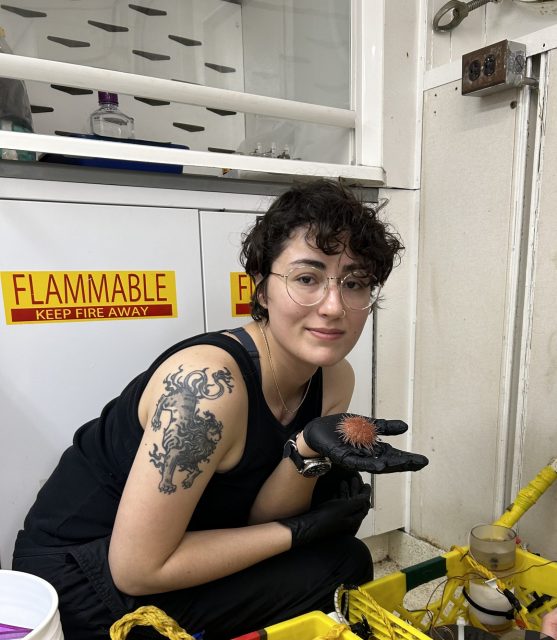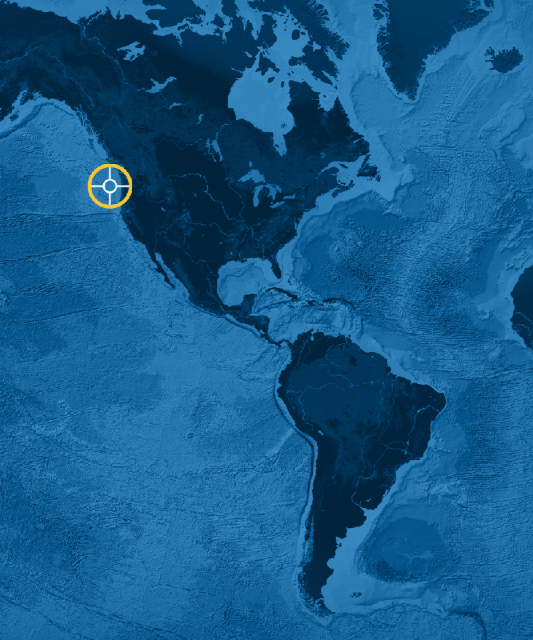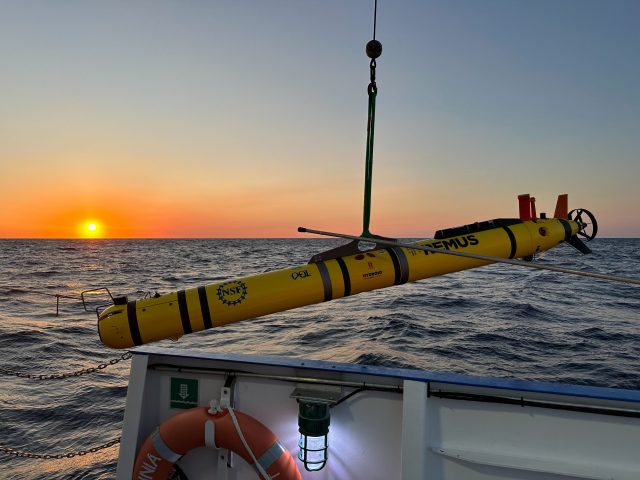News
Life at Sea: Student Reflections from the VISIONS’24 (Leg 2) Expedition
As part of the Regional Cabled Array operations and maintenance 2024 cruise, a cohort of 24 undergraduates spanning different countries of origin, states, and socio-economic backgrounds, participated in the expedition as part of the UW at-sea experiential learning program called VISIONS. This program has allowed over 200 undergraduate students, studying myriad disciplines, the opportunity to spend 8-45 days at sea on NSF-funded global class research ships utilizing state-of-the art remotely operated vehicles (ROV). Onboard, they stand 4-hr on, 8-hr off watches in the ROV control room working alongside the pilots, and RCA engineers and scientists. They work out on deck, learn about ship operations, and gain skills in oceanographic sampling and analyses of fluids. They see first-hand life forms rarely seen thriving in some of the most biologically productive waters in the ocean along the Cascadia Margin, the abyss at 2900 m water depth, and on 350°C underwater hot springs at the summit of Axial Seamount – the most active underwater volcano off the Oregon coast. The interviews below provide a glimpse of VISIONS’24 student impressions of life at sea and their experiences onboard. For many, their lives are forever changed.
The cohort included students like Leo Couchon, whose passion for ocean sciences and hands-on learning brought a unique perspective to the expedition. Leo embraced the challenges and opportunities of life at sea, immersing themselves in the demanding yet rewarding work environment. Their reflections offer a window into how the VISIONS program not only provides technical skills but also fosters personal growth and a deeper connection to the oceanographic community.
What motivated you to join the VISIONS program?
I really look up to Deb as a pioneer in Ocean Sciences and was really excited about the opportunity of learning about all different types of life on a research vessel. I wanted more than anything in the world to get my sea legs. It’s difficult to get your first experience at sea/days at sea, but it’s vital for oceanographic and marine technician work.
What skills did you develop or strengthen during your time at sea that you feel will be valuable in your future career?
Over the course of the VISIONS program, I had numerous opportunities to learn new skills and techniques. I learned how to perform meticulous, detail-oriented data logging in the ROV control van, how to deploy a CTD with Niskin bottles, and sediment push core sampling techniques. In some cases, the actual skills I was learning were second to who I was learning it from. I got the chance to learn about microbial mats and sediment cores directly from Dr. Laura Lapham, and I had the opportunity to learn Oceanographic field techniques from the people who developed the equipment we were using! I also feel like I learned things that helped me develop my communication skills in this kind of unique work environment. Between the strenuous work schedule and the round-the-clock nature of the crew and science team’s activities, I began to realize how interdependent and involved different departments need to be. Being able to effectively communicate within this was so important to my takeaway from this experience – everyone has something important to offer in terms of insight, even other students, and being able to navigate that interdependence and make a point to talk to everybody on the boat did a lot to enrich my experience.
How do you see the skills and experiences gained from the seagoing and Ocean 411 class, contributing to your role in the future workforce, particularly in science and engineering fields?
It was inspiring to be surrounded by professionals in the field I want to spend my life in; having that sense of responsibility and dedication is intoxicating. It’s something that I’ll bring with me to every future position I hold. I want to do meaningful science that involves the communities that I work within, and I want to learn enough that I can teach people. I loved being connected to everyone on the boat, getting to hear people’s stories and personal connections are important for science communication. There are still so many people out there that don’t even know what oceanography is as a field let alone how all of the pieces of the puzzle fit together. I am so genuinely excited to share my experience with anyone that will listen. I think that the skills I learned during VISIONS will be incredibly important to my future career in research, but moreover I believe that this experience increased my capacity to be effective in science communication.
What advice would you give to other students considering applying for experiential learning programs like VISIONS?
You can only get as much from the program as you put in, so apply yourself to everything that comes your way because you’ll never know what you can get from it. It’s difficult to put yourself out there but it’s worth it. Saying yes to everything that comes your way and always being willing to help everyone during the program is vital in learning a variety of skills. That said I also recommend advocating for your needs and ensuring you not to overload yourself. Carving out time for yourself to rest, reflect, and enjoy the experience for what it is can be equally important.
What was the most surprising thing you experienced during your time at sea?
There are so many people on the boat in one space and everyone is working 24/7, there’s always someone in the middle of their sleep while someone is in the middle of their shift and there is always something to learn – but it’s also routine. You just melt into the way that the boat operates. It’s the little moments that would catch me off guard. There was a night at around 2am where I left the darkness of the control van lit only by the ROV’s camera at around 2000 meters deep to be met with the expanse of the sky reflecting the end of the Perseids meteor shower. Or a day when I fully bawled on deck after everyone rushed out to see a dolphin pod following and I caught a glimpse of my favorite fish that I never thought I would get to see in person, the Mola mola. There is a sense of magic that’s difficult to put into words. You can’t ever quite carve out a moment of silence or time alone but you’re experiencing everything aboard with everyone. It’s both connecting and isolating all at once, the things that make it difficult are the very same things that make it beautiful.
[caption id="attachment_35504" align="alignnone" width="640"]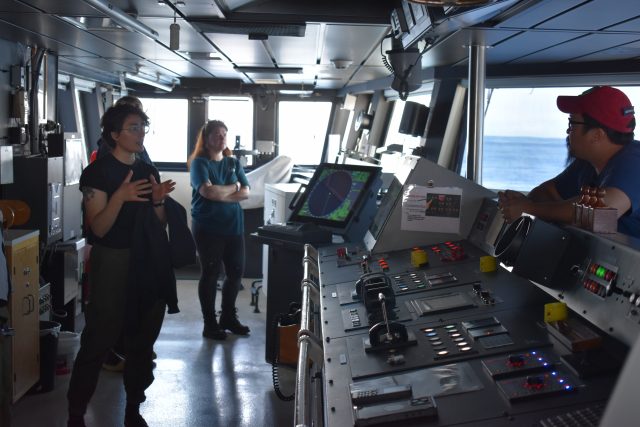 Bridge tour. (c) Kellen Rosburg[/caption]
[caption id="attachment_35503" align="alignnone" width="640"]
Bridge tour. (c) Kellen Rosburg[/caption]
[caption id="attachment_35503" align="alignnone" width="640"]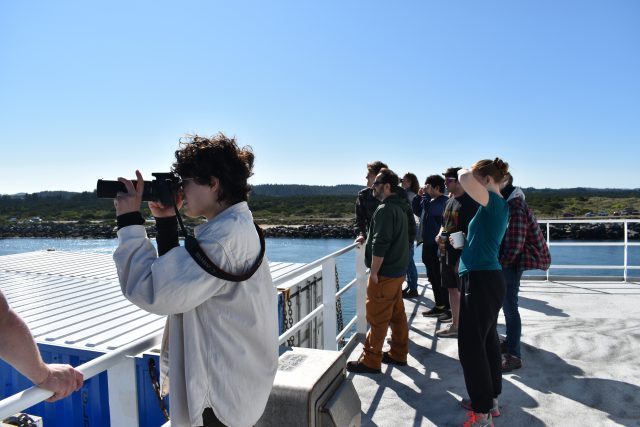 End of Leg 2. (c) Mitch Elend[/caption]
[caption id="attachment_35506" align="alignnone" width="640"]
End of Leg 2. (c) Mitch Elend[/caption]
[caption id="attachment_35506" align="alignnone" width="640"]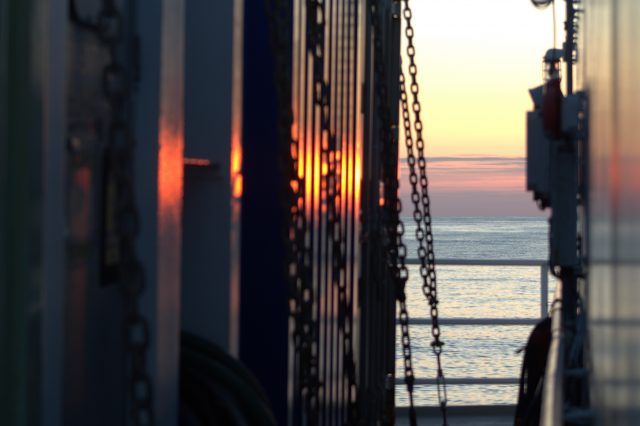 Sunrise on deck. (c) Leo Couchon[/caption]
Read More
Sunrise on deck. (c) Leo Couchon[/caption]
Read More Advancing Ocean Carbon Science: Highlights from OOI’s SUGR Meeting on Data Quality and Best Practices
On Sunday, December 8th, the Ocean Observatories Initiative (OOI) hosted its first Scientific User Group for Research (SUGR) meeting in Washington, D.C., prior to the AGU Fall Meeting. Held at The Westin DC Downtown, the event brought together researchers, scientists, and members of the user community to discuss the critical role of OOI data in advancing our understanding of the Carbon Cycle.
Exploring Ten Years of Insights and Innovation
The SUGR meeting provided a platform to review a decade of advancements in ocean carbon science supported by OOI data. Key presentations included:
- Ten Years of pCO₂ and pH Measurements on the NSF OOI Regional Cabled and Endurance Arrays: Techniques, Validation, and Science Opportunities presented by Ed Dever, Wendi Ruef, and Chris Wingard (OOI/OSU), highlighted the data generated by the Regional Cabled Array and Endurance Array. This dataset, including ten years of hourly pH and pCO₂ measurements, revealed significant variability and highlighted the potential for long-term monitoring to advance our understanding of ocean carbon processes.
- Using OOI Data to Investigate Carbon Cycling in the Irminger Sea, presented by Meg Yoder (Boston College), explored the unique challenges and opportunities associated with studying carbon cycling in the North Atlantic, leveraging OOI data for cutting edge research in this remote and dynamic region.
- OOI Biogeochemical Working Group & Data User Guide and 7 Reasons Why You Need It! presented by Merrie Beth Neely (Global Science & Technology), emphasized the value of the Biogeochemical Data User Guide and how it supports researchers in navigating and utilizing OOI’s vast datasets effectively.
- The Pioneer MAB Array: Location and Sensors, presented by Al Plueddemann (OOI/WHOI), provided an overview of the Pioneer Array’s configuration and sensor capabilities, highlighting its role in enhancing our understanding of shelf dynamics and biogeochemical processes.
- RCA Instrument Refresh, presented by Mike Vardaro (OOI/UW), focused on recent upgrades to the Regional Cabled Array’s instrumentation, ensuring its continued functionality for supporting new oceanographic research.
- NOAA Ocean Acidification and OOI Data, presented by Liza Wright-Fairbanks (NOAA OAP), highlighted the integration of OOI data with NOAA’s efforts to monitor and address ocean acidification.
The meeting fostered a collaborative atmosphere, with attendees sharing insights and identifying opportunities to enhance the value of OOI data. The discussions extended to updating the GOOS-Endorsed Best Practices document and exploring ways to integrate OOI datasets more seamlessly with other oceanographic networks.
Session Highlights and Key Takeaways
- Innovative Tools and Techniques: The discussions touched on the importance of deploying advanced tools to maximize the impact of OOI data. High-resolution pH and DIC sensors, microbial fuel cells for renewable energy and CO₂ fixation, and imaging flow cytometers were highlighted as transformative technologies for biogeochemical research.
- Data Quality and Calibration: Speakers emphasized the critical need for rigorous data validation and quality control processes. Challenges such as fouling and sensor drift were addressed, with proposed solutions including the development of improved calibration standards and updated best practices manuals.
- Expanding Community Engagement: Participants stressed the importance of user-driven collaboration in refining tools like the Biogeochemical Sensor Data Best Practices & User Guide. Suggestions included organizing science-themed webinars, leveraging existing resources, and enhancing tutorial accessibility to better support the community.
Future Plans
As OOI continues to evolve, SUGR meetings will remain central to addressing challenges, exploring innovations, and driving impactful research.
We welcome your suggestions for future SUGR meeting topics and areas of focus. Your input is critical in shaping OOI’s future efforts. Lastly, the OOI looks forward to working with you, our biogeochemical data champions, to continue to improve best practices for BGC research.
For more information and access to post-event resources, visit the SUGR Ocean Carbon Science webpage.
[caption id="attachment_35489" align="alignnone" width="640"]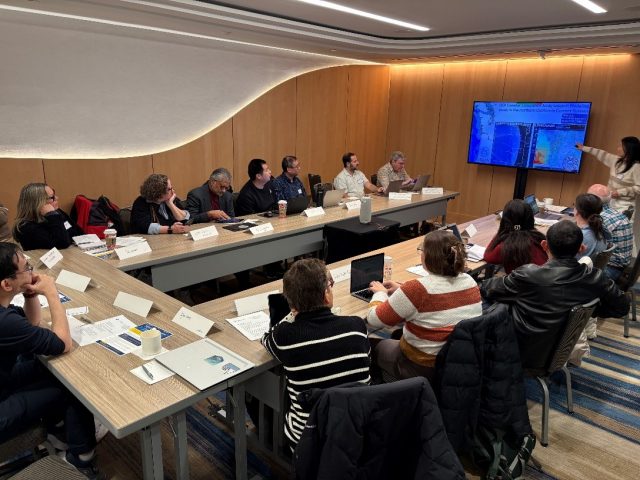 OOI SUGR Meeting, Dec 8th, Washington, DC[/caption]
[caption id="attachment_35491" align="alignnone" width="640"]
OOI SUGR Meeting, Dec 8th, Washington, DC[/caption]
[caption id="attachment_35491" align="alignnone" width="640"]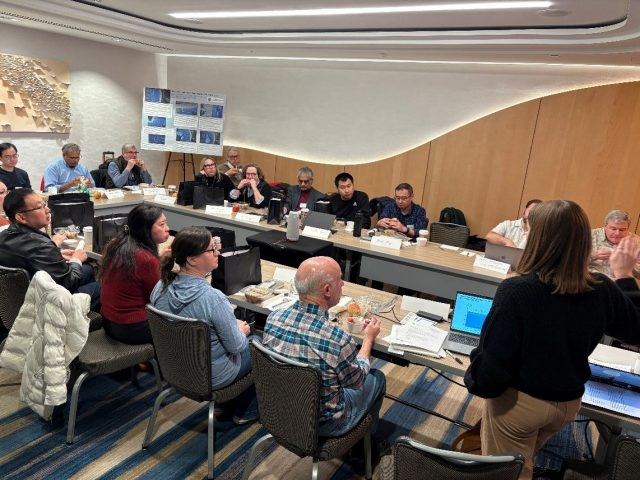 Meg Yoder, Boston College[/caption]
Read More
Meg Yoder, Boston College[/caption]
Read More Ocean Observatories Initiative at the 2024 AGU Conference
The Ocean Observatories Initiative (OOI) participated in the 2024 American Geophysical Union (AGU) Fall Meeting in Washington, D.C. This premier event served as a global platform for thousands of scientists and researchers to share breakthroughs and foster collaborations in Earth and space sciences. OOI took part in presentations, interactive discussions, and participation in the Ocean Observatories Initiative Facilities Board (OOIFB) Town Hall.
OOIFB Town Hall
A key event at AGU was the OOIFB Town Hall held on December 10th. This in-person session provided an opportunity for the community to engage directly with OOI representatives, NSF and NOAA program leaders, and the OOIFB. The event featured:
- Updates from OOI’s Principal Investigator (PI), Jim Edson who shared the latest developments from the Program Management Office (PMO) and the Marine Implementing Organizations (MIOs).
- Interactive Panel Discussion: A panel of experts, including representatives from OOI’s Endurance Array, Mid-Atlantic Bight Array (MAB), Regional Cabled Array (RCA), and PMO discussed opportunities and challenges for observatory-based research.
Participants heard from PI’s about the proposal process and discussed opportunities for adding new instruments to the infrastructure. The session emphasized the importance of community input and encouraged feedback to inform OOI’s future directions.
The panel members included:
- Jim Edson (OOI/WHOI)
- Al Plueddemann (OOI/WHOI)
- Ed Dever (OOI/OSU)
- Mike Vardaro (OOI/UW)
- George Voulgaris (NSF)
- Kaity Goldsmith (NOAA)
Researchers, educators, and scientists using or considering OOI data were encouraged to share their insights, helping to shape future OOI research and initiatives. Examples involved the use of existing OOI data and the addition of new sensors by external PIs for specific research projects. Other opportunities to use OOI infrastructure was discussed including the use of available space on our Operations and Maintenance cruise. Making better use of individual observing systems by combining measurement capabilies (e.g., between NSF/OOI and NOAA) was discussed as an action item.
Engaging at the OOI Booth
The OOI exhibit booth was a hub of activity throughout the conference. Attendees explored live demonstrations of OOI’s data tools, learned about recent updates to infrastructure, and connected with OOI representatives to discuss potential collaborations. The booth provided an accessible entry point for researchers new to OOI data and offered experienced users an opportunity to delve deeper into its capabilities.
Looking Ahead
Through discussions, booth interactions, and participation in the OOIFB Town Hall, OOI demonstrated its commitment to innovation and collaboration. Looking forward, OOI remains dedicated to fostering an engaged community of researchers. The feedback and ideas gathered during AGU will help shape OOI’s next steps, ensuring its data and infrastructure continue to meet the needs of the scientific community.
For more information on OOI’s resources, presentations, and opportunities for collaboration, visit our website or follow us on social media.
[caption id="attachment_35482" align="alignnone" width="640"]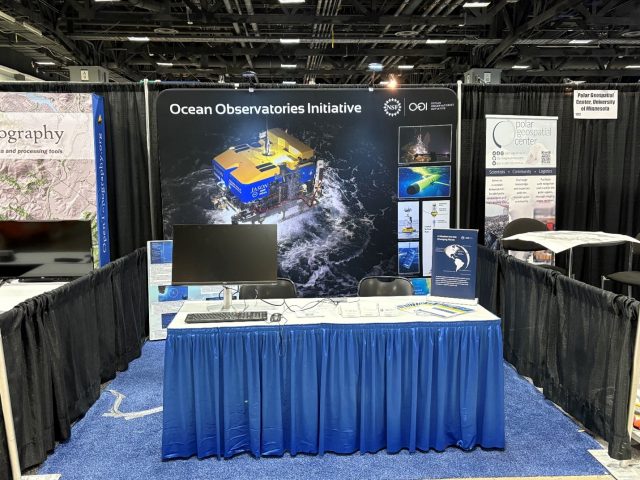 OOI at AGU[/caption]
[caption id="attachment_35483" align="alignnone" width="640"]
OOI at AGU[/caption]
[caption id="attachment_35483" align="alignnone" width="640"]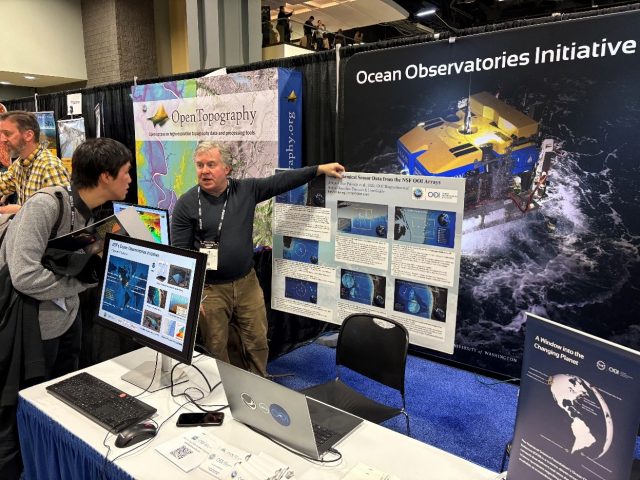 Jim Edson, OOI’s Principal Investigator[/caption]
[caption id="attachment_35484" align="alignnone" width="640"]
Jim Edson, OOI’s Principal Investigator[/caption]
[caption id="attachment_35484" align="alignnone" width="640"]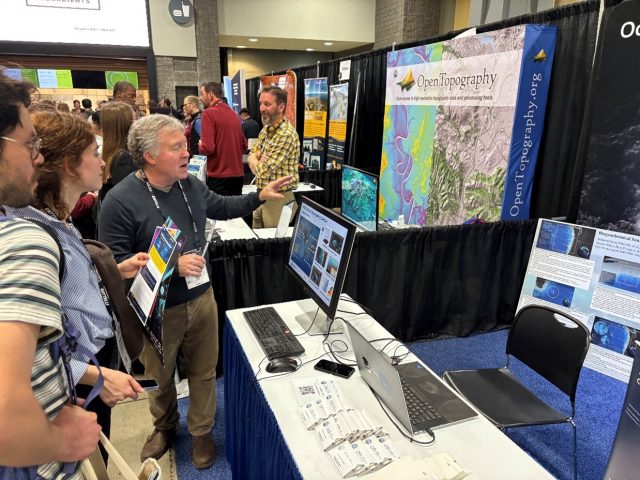 Jim Edson, OOI’s Principal Investigator[/caption]
Read More
Jim Edson, OOI’s Principal Investigator[/caption]
Read More Sea-Bird Scientific Issues Notice for Certain CDOM Fluorometers
Sea-Bird Scientific has issued a notice regarding certain CDOM fluorometers, which have been reported to produce biased measurements. The source of this bias has been identified as stemming from three distinct root causes:
- Incorrect primary CDOM standard
- In situ bias
- Out-of-tolerance UV LED
Exploring OSU’s Ocean Observatories Initiative Through Virtual Reality
Students and faculty at the Oregon Institute of Marine Biology (OIMB) had the opportunity to participate in a 360-degree virtual reality (VR) tour of Oregon State University’s (OSU) U.S. National Science Foundation’s Ocean Observatories Initiative (OOI) Ocean Observing Center in Corvallis. Led by Dr. Jonathan Fram, co-PI and project manager for the OOI Endurance Array, the tour provided an in-depth look at the advanced instruments and systems used to study the ocean’s physical, chemical, geological, and biological processes.
Hosted remotely, the tour allowed participants at OIMB to engage with the facility through live-streamed video, filmed using cutting-edge VR technology by Darryl Lai from OSU Productions. This immersive format enabled attendees to explore the facility virtually and ask real-time questions, making it an accessible and informative experience.
The event was complemented by guest lectures from visiting oceanographers Dr. Léo Mahieu and Dr. Mareike Körner, postdoctoral researchers from OSU’s College of Earth, Ocean, and Atmospheric Sciences (CEOAS). They shared insights about their research and career trajectories, offering inspiration and guidance to students interested in oceanography.
This unique event showcased the innovative tools and collaborative efforts that the OOI is using to advance modern ocean research. Check out the recording of the OSU/OOI tour here.
Read MoreIrminger Sea Carbon Cycle
The high-latitude North Atlantic, a region with high phytoplankton production in the spring and deep convection in the winter, is of particular importance for the global carbon cycle. The vertical transport of carbon from near the surface into the deep ocean, by combination of biological and physical processes, is known as the biological carbon pump. The carbon pump is particularly active in the Irminger Sea, yet the carbon budget, and its seasonal and interannual variability, are poorly known. A study by Yoder et al. (2024) used carbon system data from multiple observational assets (moorings and CTD casts) of the OOI Irminger Sea Array to assess net community production in the mixed layer and the implications for the biological pump in this region.
Data analysis was challenging, because it involved working with multiple instrument types, gappy records, calibration offsets, and other idiosyncrasies. In addition, data from multiple instruments and observing platforms needed to be combined to produce continuous records. The primary sensors utilized were pH and pCO2. These are difficult sensors to work with, to the extent that a community workshop was convened to develop a “users guide” to best practices for analysis (Palevsky et al., 2023). Yoder et al. were able to quality control, cross-calibrate, and merge data from the OOI surface mooring, flanking moorings, gliders and shipboard CTD casts (Fogaren and Palevsky 2023; Palevsky et al. 2023) to create the first multi‐year time series of the inorganic carbon system for the Irminger Sea mixed layer. This remarkable data set, based on instruments with sample rates of 1-2 hours, provides a seven-year record with near-daily resolution (Figure 28).
The time series results (Figure 3) showed that carbon system variables (dissolved inorganic carbon (DIC), total alkalinity (TA), and partial pressure of CO2 (pCO2)) co-vary through the annual cycle, with minimums in late summer at the end of the productive season and maximums in winter. The summer draw-down of pCO2 indicates that biophysical effects, rather than temperature, are the primary drivers of pCO2 variability. The influence of vertical mixing and primary productivity can be clearly seen in DIC and TA. In the subpolar North Atlantic, shoaling of the mixed layer in spring is generally associated with spring phytoplankton blooms, as indicated by increasing chlorophyll (Chl) concentration. Interestingly, it is found that highest integrated rates of DIC removal from the mixed layer via photosynthesis take place prior to mixed layer shoaling.
After a thorough analysis that included mixed layer budgets of DIC and TA, followed by assessment of gas exchange, physical transport, and the hydrologic cycle, the authors conclude that strong biological drawdown is the primary removal mechanism of inorganic carbon from the mixed layer. Furthermore, they point out the importance of interannual variability in both the drivers of and resulting magnitude of surface carbon cycling. This is primarily due to variability in net community production. Acknowledging the challenges taken on by OOI to maintain an array in the Irminger Sea, the authors note that “collecting observational data is both costly and challenging, however if only 1 year of data is collected or multiple years are averaged together, [carbon system dynamics] … will be misrepresented.”
This project shows the potential for OOI data, with appropriate processing and analysis, to provide unique insights into the ocean carbon system. It is notable that the authors made a substantial effort to calibrate and combine data from multiple instruments and moorings, and to take advantage of ancillary data (e.g. gliders, OOI CTD casts, and non-OOI CTD casts) in their processing. Enabling this type of analysis was a goal in the design of the multi-platform OOI Arrays and shipboard validation protocols.
[caption id="attachment_34983" align="alignnone" width="623"] Time series of dissolved inorganic carbon (DIC), total alkalinity (TA), partial pressure of CO2 (pCO2) temperature, chlorophyll-a (Chl), and mixed layer depth (MLD) in the Irminger Sea mixed layer from 2015-2022. Colors identify annual cycles. From Yoder et al., 2024.[/caption]
Time series of dissolved inorganic carbon (DIC), total alkalinity (TA), partial pressure of CO2 (pCO2) temperature, chlorophyll-a (Chl), and mixed layer depth (MLD) in the Irminger Sea mixed layer from 2015-2022. Colors identify annual cycles. From Yoder et al., 2024.[/caption]
___________________
References:
- Fogaren, K. E., Palevsky, H. I. (2023) Bottle-calibrated dissolved oxygen profiles from yearly turn-around cruises for the Ocean Observations Initiative (OOI) Irminger Sea Array 2014 – 2022. Biological and Chemical Oceanography Data Management Office (BCO-DMO). Version Date 2023-07-19 doi:10.26008/1912/bco-dmo.904721.1
- Palevsky, H.I., S. Clayton and 23 co-authors, (2023).OOI Biogeochemical Sensor Data: Best Practices & User Guide Global Ocean Observing System, 1(1.1), 1–135. https://doi.org/10.25607/OBP-1865.2
- Palevsky, H. I., Fogaren, K. E., Nicholson, D. P., Yoder, M. (2023) Supplementary discrete sample measurements of dissolved oxygen, dissolved inorganic carbon, and total alkalinity from Ocean Observatories Initiative (OOI) cruises to the Irminger Sea Array 2018-2019. Biological and Chemical Oceanography Data Management Office (BCO-DMO). Version Date 2023-07-19 doi:10.26008/1912/bco-dmo.904722.1
- Yoder, M. F., Palevsky, H. I., & Fogaren, K. E. (2024). Net community production and inorganic carbon cycling in the central Irminger Sea. J. Geophys. Res., 129, e2024JC021027. https://doi.org/10.1029/2024JC021027
Impact of Ocean Model Resolution on Temperature Inversions in the Northeast Pacific Ocean
Temperature inversions are a local vertical minimum in temperature located at a shallower depth than a local maximum. In the Northeast Pacific, several water masses and multiple mechanisms for transforming or advecting ocean temperature (cold air events, upwelling, river discharge, cross-shelf eddy transport) create favorable conditions for temperature inversions. Modeling these temperature inversions is challenging. Osborne et al. (2023) analyze observations from 2020 and 2021 to characterize inversions in the Northeast Pacific. The data for these observations come largely from OOI Endurance Array gliders accessed through the GTS database. They compare the observed inversions to model results from the U.S. Navy’s Global Ocean Forecast System version 3.1 (GOFS 3.1) and two instances of the Navy Coastal Ocean Model. Temperature inversions are observed to be present in about 45% of profiles with temperature minimums between 50 – 150 m, temperature maximums between 75 – 175 m, and inversion thickness almost entirely less than 40 m. Modeled temperature inversions are present in only about 5% of model-observations comparisons, with weaker, shallower minimums. This is attributed to two primary causes: coarse model resolution at the inversion depth and the assimilation process which low-pass filters temperature, making inversions weaker. Osborn et al. identify additional work to test the impact of vertical grids on improving model performance.
[caption id="attachment_34977" align="alignnone" width="392"] Maps of inversion counts for observed profiles collected during 2020-2021 and analyzed in this work. Profiles have been filtered to be offshore of the 200 m isobath and to only one profile per collection platform per day (e.g., one profile per glider per day). Black line near the coast marks the 200 m isobath. Light gray indicates no profiles collected during the study period.[/caption]
Maps of inversion counts for observed profiles collected during 2020-2021 and analyzed in this work. Profiles have been filtered to be offshore of the 200 m isobath and to only one profile per collection platform per day (e.g., one profile per glider per day). Black line near the coast marks the 200 m isobath. Light gray indicates no profiles collected during the study period.[/caption]
___________________
References:
J. Osborne V, C. M. Amos and G. A. Jacobs, “Impact of Ocean Model Resolution on Temperature Inversions in the Northeast Pacific Ocean,” OCEANS 2023 – MTS/IEEE U.S. Gulf Coast, Biloxi, MS, USA, 2023, pp. 1-8, doi: 10.23919/OCEANS52994. 2023.10337390.
Read MoreNew Hints When Axial Might Erupt: Precursor Events Detected Through Machine Learning
A recent paper by Wang et al., “Volcanic precursor revealed by machine learning offers new eruption forecasting capability” [1] describes the characterization of time-dependent spectral features of earthquakes at Axial Seamount prior to the 2015 using unsupervised machine learning (this method applies algorithms to analyze data without humans in the loop). A major finding from this work is the identification of a distinct burst of mixed-frequency earthquake (MEF) signals that rapidly increased 15 hours prior to the start of the eruption, peaked one hour before lavas reached the seafloor, and earthquakes at Axial Seamount prior to the 2015 using unsupervised machine learning (this method applies algorithms to analyze data without humans in the loop). A major finding from this work is the identification of a distinct burst of mixed-frequency earthquake (MEF) signals that rapidly increased 15 hours prior to the start of the eruption, peaked one hour before lavas reached the seafloor, and migrated along pre-existing faults. The earthquakes are thought to reflect brittle failure driven by magma migration and/or degassing of volatiles. The source mantle beneath Axial Seamount contains extremely high CO2 concentrations leading to high concentrations in the melts [3,4]. MEFs were detected for months prior to the eruption, which could result from volatile release associated with inflation of the sills that feed Axial [5]. Importantly, the identification of these signals may help forecasting of the upcoming Axial eruption and may also be applied to other active volcanoes.
The authors utilized a wealth of geophysical data from the past decade to present an integrated view of Axial (Figure 1) including a subset of earthquake data 4 months prior to the eruption (67,767 out of their >240,000 earthquake catalogue from the RCA seismic array [2]), coupled with bottom pressure from BOTPT instruments at the Central Caldera and Eastern Caldera sites, and 3D modeling.
[caption id="attachment_34973" align="alignnone" width="640"]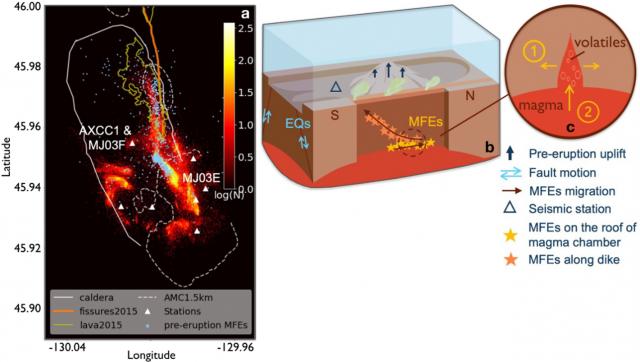 After Wang et al., 2024 [1] Figures 1 and 4: a) Heatmap of earthquake density at Axial Seamount from Nov 2014 to Dec 2021 [2]. Image highlights mixed‐frequency earthquakes (MFEs – light blue dots) one day before the eruption, the caldera rim (white solid line), the 1.5 km depth contour of the Axial magma chamber (AMC)(dashed white line), eruptive fissures (orange lines), lava flows of the 2015 eruption (yellow lines), the location of the RCA short-period seismometer array (white triangles),broadband seismometer AXCC1 and bottom pressure tilt instruments (MJ03E and MJ03F. Heatmap shows the number of earthquakes in each 25 m × 25 m bins. b) Cartoon summarizing observations. Tidally‐driven earthquakes occur on caldera ring faults, while the MFEs track movement of volatiles and magma prior to the eruption. c) possible mechanisms of the MFEs. ① and ② correspond to crack opening and volatile/magma influx processes.[/caption]___________________
After Wang et al., 2024 [1] Figures 1 and 4: a) Heatmap of earthquake density at Axial Seamount from Nov 2014 to Dec 2021 [2]. Image highlights mixed‐frequency earthquakes (MFEs – light blue dots) one day before the eruption, the caldera rim (white solid line), the 1.5 km depth contour of the Axial magma chamber (AMC)(dashed white line), eruptive fissures (orange lines), lava flows of the 2015 eruption (yellow lines), the location of the RCA short-period seismometer array (white triangles),broadband seismometer AXCC1 and bottom pressure tilt instruments (MJ03E and MJ03F. Heatmap shows the number of earthquakes in each 25 m × 25 m bins. b) Cartoon summarizing observations. Tidally‐driven earthquakes occur on caldera ring faults, while the MFEs track movement of volatiles and magma prior to the eruption. c) possible mechanisms of the MFEs. ① and ② correspond to crack opening and volatile/magma influx processes.[/caption]___________________
References:
[1] Wang, K., F. Waldhouser, M. Tolstoy, D. Schaff, T. Sawi, W.S.D. Wilcock, and Y.J. Tan (2024) Volcanic precursor revealed by machine learning offers new eruption forecasting capability. Geophyiscal Research Letters, 51 (19) https://doi.org/10.1029/2024GL108631.
[2] Wang, K., F. Waldhouser, D.P. Schaff, M. Tolstoy, W.S.D. Wilcock, and Y.J. Tan (2024) Real-time detection of volcanic unrest and eruption at Axial Seamount using machine learning. Seismological Research Letters, 95, 2651–2662, doi: 10.1785/0220240086.
[3] Helo, C., M.-A. Longpre, N. Shimizu, D.A. Clague and J. Stix. (2011) Explosive eruptions at mid-ocean ridges driven by CO2-rich magmas. Nature Geoscience. 4, 260–263 (2011). https://doi.org/10.1038/ngeo1104.
[4] Dixon, J. E., E. Stolper, E., and J.R. Delaney (1988). Infrared spectroscopic measurements of CO2 and H2O in Juan de Fuca Ridge basaltic glasses. Earth and Planetary Science Letters, 90(1), 87–104. https://doi.org/10.1016/0012‐821x(88)90114‐8.
Read MoreOOI-CGSN Team Completes First Standalone AUV Cruise at Pioneer MAB Array
The Ocean Observatories Initiative’s (OOI) Coastal and Global Scale Nodes (CGSN) team recently conducted their first standalone small vessel Autonomous Underwater Vehicle (AUV) cruise at the Pioneer Mid-Atlantic Bight (MAB) Array. Aboard the R/V Virginia, team members Andy Robinson, Collin Dobson, and Dan Bogorff successfully completed dock testing of their launch and recovery systems before heading offshore to carry out AUV transects through the array.
The mission utilized two REMUS600 AUVs, equipped with a variety of scientific instruments, including CTDs (conductivity, temperature, depth), fluorometers, dissolved oxygen sensors, nitrate sensors, photosynthetically active radiation (PAR) sensors, and ADCPs (acoustic doppler current profilers). These tools provide essential data for understanding ocean conditions and biogeochemical processes at the Pioneer MAB array.
This accomplishment highlights the OOI-CGSN team’s dedication to advancing autonomous AUV ocean exploration and data-driven research.
[gallery size="full" ids="34951,34952,34953,34954,34955,34956"](c): Collin Dobson
Read MoreUpcoming OOI SUGR Meeting Focused on Advancing Ocean Carbon Research
The Ocean Observatories Initiative (OOI) is hosting a Scientific User Group for Research (SUGR) meeting just before the AGU conference in Washington, D.C. on Sunday, December 8th from 11am-2pm ET. This meeting will serve as a platform for both current and potential users of OOI and other datasets to collaborate on research efforts aimed at improving our understanding of the Carbon Cycle.
The SUGR meeting will feature key presentations on ocean carbon science and data quality, followed by a discussion on updating the GOOS-Endorsed Best Practices document to incorporate the latest scientific advancements. Attendees will also see a demonstration of the OOI data explorer, highlighting its role in improving data quality assessments and research. Additionally, the meeting will invite input on potential new sensors to enhance OOI’s infrastructure, further supporting biogeochemical research.
This is an excellent opportunity to collaborate, share experiences, and learn more about how OOI data contributes to carbon cycle research.
The meeting will last for three hours and include a lunch break, with boxed lunches provided for in-person attendees. If you’re interested in attending, please contact Amber Coogan, OOI’s Community Engagement Manager, at amber.coogan@whoi.edu, and indicate whether you’d prefer to attend in person or virtually.
Note: AGU registration is not required to participate in the SUGR meeting.
Read More
